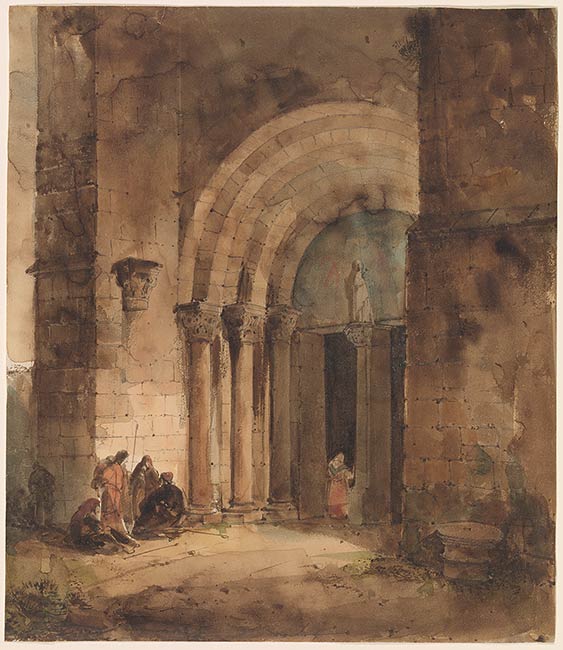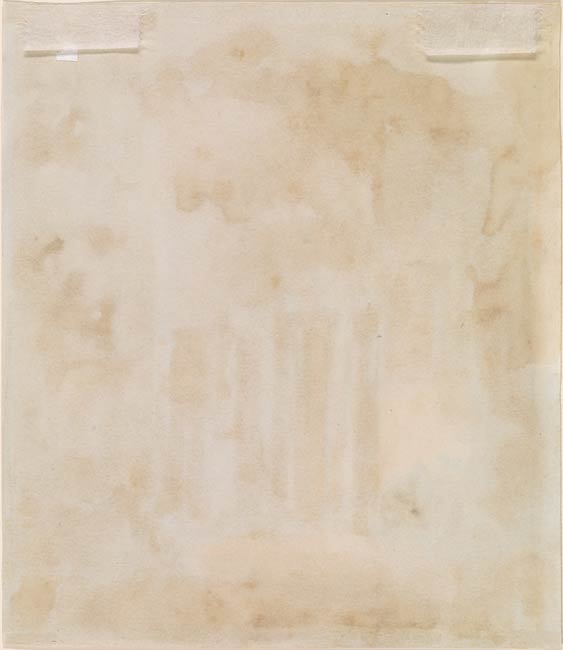

Granet's Catholicism and interest in medieval architecture (he was the son of a master mason) was shared by some of his colleagues in Jacques-Louis David's studio, notably Fleury-François Richard (1777-1852) and Pierre-Henri Révoil (1776-1842). Étienne Jean Delécluze related that shortly after leaving David's atelier, Garnet took a studio in a Capuchin monastery on the rue de la Paix, alongside Gros, Ingres, and Girodet. According to Délecluze, [Granet] “who was to become famous for portraying convent interiors, began by painting the long corridors of the Capucines convent... every day Granet... established himself in the cloister with his easel and canvas...” (Delécluze 1855, p. 298). The artist earned a great deal of popular praise for his mysterious views of dimly lit church interiors peopled with monks performing religious rituals. He first presented such a subject, The Cloister of the Feuillants (Le Cloître des Feuillants), at the Salon of 1779 and thereafter continued to produce and exhibit these popular scenes throughout his career. Having departed for Rome in 1802, in 1814 Granet achieved overwhelming success with Choir of The Capuchin Church in Rome, which earned the artist wide public and official acclaim and warranted the production of no less than thirteen variants.
This watercolor is preparatory for a lithograph in the Voyages pittoresques et romantiques dans l'Ancienne France, a seventeen-volume work assembled by Charles Nodier, Baron Justin Taylor, and Alphonse de Cailleux and published by Firmin Didot in 1829-33 (pl. 14). The large number of reproductions-mostly of picturesque landscapes or architectural studies - resulted in commissions for many French artists during the first half of the nineteenth century. The lithograph after the present drawing was executed by Jean-Baptiste Arnoult (b. 1788) and is inscribed Granet del. 1831. The plate is titled Vue de la porte de l'église de Marsel [sic] près de Riom, Auvergne, and represents Nôtre Dame de Marsat in the Auvergne. The lithograph closely corresponds to Granet's drawing, although Arnoult clarified the figures significantly, rendering the seated one at left as a mother with child. A second plate for the Voyages pittoresques, titled Vue de la nef de l'église de Cebazat, was produced by Adrien Dauzats (1804-1868) based on a drawing by Granet, which Isabelle Néto-Daguerre dates to 1820 (pl. 32). Granet may have executed the present sheet on one of his trips between Aix-en-Provence and Paris in 1831, according to the date inscribed on the print. Notre Dame de Marsat is first mentioned by Gregory of Tours in the sixth century, and was the site of a women's priory in the seventh century. By the twelfth century, in concert with the nearby abbey of Mozac, it adopted the Rule of St. Benedict, eventually developing a strong cult of the Virgin. The church combines Romanesque architectural elements from the tenth to twelfth centuy, with fifteenth and sixteenth century Gothic vaulting, an eighteenth century belltower and later adornments. Granet chose to depict the Romanesque entrance portal on the south façade, which is flanked by buttresses and framed by slender columns with carved capitals and round arches. At center of the tympanum above the door is a stone Virgin and Child, which is now mounted along a wall to the left of the portal. A more precise rendering of the portal from the 1820s by Jean-Baptiste Jorand, is in the Bibliothèque nationale de France, Paris (EST RESERVE VE-26 (Q).
Watermark: none.
Thaw, Eugene Victor, former owner.
Thaw, Clare, former owner.
Thaw Catalogue Raisonné, 2017, no. 180, repr.
The Thaw Collection : Master Drawings and Oil Sketches : Acquisitions since 1994. New York : Pierpont Morgan Library, 2002, no. 33, repr.
Delécluze 1855, E.J. Delécluze, Louis-David: Son école et son temps, Paris, 1855.
